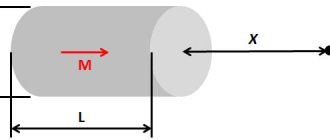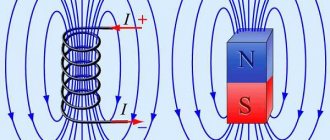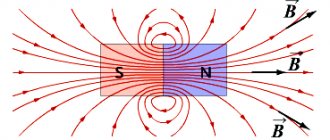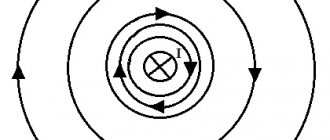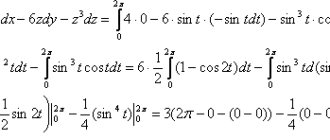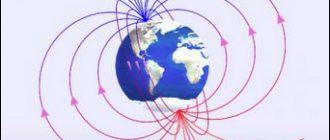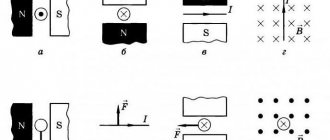Electromagnetic screens are widely used in industry. They serve to eliminate the harmful influence of some elements of an electrical device on others, to protect personnel and equipment from the effects of external fields that arise during the operation of other devices. “Quenching” of the external magnetic field is necessary when creating laboratories intended for setting up and testing highly sensitive equipment. It is also required in medicine and those fields of science where ultra-low induction fields are measured; to protect information during its transmission over cables.
Methods
You might be interested in: Adaptive learning technology. Requirements for a modern lesson
Magnetic field shielding is a set of methods for reducing the strength of a constant or alternating field in a certain area of space. A magnetic field, unlike an electric one, cannot be completely weakened.
In industry, the greatest impact on the environment is caused by stray fields arising from the operation of transformers, permanent magnets, high-current installations and circuits. They can completely disrupt the normal operation of neighboring devices.
Most often, 2 protection methods are used:
- The use of screens made of superconducting or ferromagnetic materials. This is effective in the presence of a constant or low frequency magnetic field.
- Compensation method (quenching by eddy currents). Eddy currents are volumetric electric currents that arise in a conductor when the magnetic flux changes. This method shows the best results for high-frequency fields.
Outdoor EMP protection
In an urban environment, people constantly encounter electrical networks, ubiquitous cellular communications, and travel by electric transport - electric trains, trams and trolleybuses. Some houses are located near high-voltage power lines.
The state should protect the population from the effects of power lines by creating the boundaries of sanitary protection zones, reducing the electric field in residential buildings, institutions, office buildings, and places of long-term stay of citizens by using a shielding coating. It is necessary to introduce rules for the construction of any buildings at the legislative level, taking into account the location of nearby power lines, providing buildings with grounding, proper electrification, shielding, and, if necessary, strictly prohibiting construction that deviates from these standards. In reality, alas, this does not happen due to the cost of research.
Principles
You may be interested in: Domovina is the last refuge
The principles of magnetic field shielding are based on the laws of magnetic field propagation in space. Accordingly, for each of the above methods they are as follows:
- If you place an inductor in a casing made of a ferromagnetic material, then the induction lines of the external magnetic field will pass along the walls of the protective shield, since it has less magnetic resistance compared to the space inside it. Those power lines that are induced by the coil itself are also almost all closed to the walls of the casing. For the best protection in this case, it is necessary to choose ferromagnetic materials that have high magnetic permeability. In practice, iron alloys are most often used. In order to increase the reliability of the screen, it is made thick-walled or assembled from several casings. The disadvantages of this design are its heaviness, bulkiness and deterioration of shielding in the presence of seams and cuts in the walls of the casing.
- With the second method, the weakening of the external magnetic field occurs as a result of the superposition of another field induced by ring eddy currents. Its direction is opposite to the induction lines of the first field. As the frequency increases, the attenuation will be more pronounced. For shielding in this case, plates in the form of a ring of conductors with low resistivity are used. Cylinder-shaped boxes made of copper or aluminum are most often used as screen-casings.
Digital library
Life safety in the technosphere / Non-ionizing electromagnetic fields and radiation. Part 1. / 3.7. Protection against magnetic fields
In case of non-compliance with the requirements of the standards (depending on the nature of the work performed and the level of magnetic field strength), practically the same measures, methods and means are used to protect against the influence of magnetic fields as for protection against the influence of electric fields:
– protection by time and distance;
– reduction of radiation parameters directly in the radiation source itself;
– shielding of the radiation source;
– shielding of the workplace;
– rational placement of installations in the workroom;
– establishment of rational modes of operation of installations and work of maintenance personnel;
– use of warning alarms;
– identification of radiation zones;
– use of personal protective equipment.
Let us briefly look at the characteristics of some protection methods. Thus, the following requirements can be considered as organizational measures to reduce the adverse effects of a constant magnetic field:
– limiting direct contact of personnel’s hands with magnetized products by using manipulators, tongs, and gaskets made of non-magnetic materials;
– insertion and removal of products from electromagnets should be carried out with the electromagnet de-energized or using the specified devices;
– implementation of magnetization of products at the last stage of the technological process;
– storage and transfer of magnetic products in thick-walled containers made of non-magnetic materials or devices and devices that close the magnetic flux;
– use of automatic devices for measuring the physical parameters of magnets and magnetic materials in technical testing areas of products.
When developing and operating DC technological installations that create a constant magnetic field in a large volume of working space, it is necessary to provide remote control of the technological process. Installation control panels must be placed outside the area in which the magnetic field levels exceed the remote control level, taking into account the operating time.
Areas of the production environment with MP levels exceeding the maximum permissible limit should be marked with special warning signs made in accordance with GOST R 12.4.026-2001 “SSBT. Signal colors and safety signs”, with an explanatory inscription: “Caution! Magnetic fields" [16].
To prevent the adverse effects of a constant magnetic field (PMF) on the hands of those working in the production of electronic products, the following measures are required:
– increase the dimensions of casings on magnetic installations that prevent contact of hands of those working with the PMP;
– introduce end-to-end technological cassettes at assembly areas, eliminating the impact of PMP on the hands of workers;
– introduce special devices of a remote operating principle for capturing devices in a magnetic field and manipulating them.
Direct current technological installations should be placed at such a distance from each other that personnel employed at one workplace do not fall within the coverage area of the PMF from another source.
When organizing workplaces (work zones), it is necessary to carry out such organizational measures to reduce the impact of PMF on the human body, such as choosing a rational work and rest regime, reducing the time spent in the conditions of PMF, determining the route of movement in the work area, limiting contact with PMF.
Rice.
3.22. Screen in the shape of a hollow ball with radii R1 and R2
Note that in addition to protection by time, distance and the above measures, the most effective technical measure for protection from a magnetic field is shielding. Shielding from constant magnetic fields is carried out by surrounding them with massive closed shells made of ferromagnetic material to protect a person or any equipment from the influence of extraneous magnetic fields. Such shells are called magnetic shields
. The field inside the screen turns out to be weakened compared to the external field.
For example, for a screen in the shape of a hollow ball with radii R1 and R2 (Fig. 3.22) and with absolute magnetic permeability of the walls m, placed in an external uniform field with induction B0, the magnetic induction B in the screen cavity is equal to [45]:
For example, if R1 = 0.8R2 and m = 4000, then B = 0.023B0. Therefore, the field strength inside the screen is 2% of the external field strength.
In the case of a screen made in the form of a cylinder with radii R1 and R2, the value of magnetic induction in the middle part of the screen at large values of the magnetic permeability of the steel from which the screen is made (m >> m0) can be determined using the following expression:
.
Here d is the thickness of the screen wall (d = R2 – R1).
The shielding effect of screens made of a ferromagnetic substance is determined by the fact that the lines of magnetic induction of the external field, trying to follow the path with the least magnetic resistance, are concentrated inside the walls of the screen, almost without penetrating into its cavity. In the same way, you can protect the external space from the effects of a magnetic field if
surround the field source with a massive closed shell of ferromagnetic material. Multi-stage screens are often used in the form of several hollow ferromagnetic bodies located one inside the other.
The principle of operation of screens that are used to protect against the effects of industrial-frequency magnetic fields will be discussed below. Here we only note that the physically shielding effect of such screens is explained not only by the fact that the magnetic resistance of the screen walls is much less than the magnetic resistance of the air, but also by the occurrence of eddy currents in the screen walls, which create their own magnetic field directed towards the external field, and thereby weaken his. Therefore, in this case, not only the value of the magnetic permeability of the material from which the screen is made is important, but also its specific conductivity.
Note that shielding devices designed to protect against magnetic fields are also good protectors (when grounded) against electric fields. However, those shielding devices that are designed to protect against electric fields and whose wall thickness is determined mainly by considerations of mechanical strength may be ineffective in protecting against magnetic fields, especially if these fields are constant.
Main characteristics
You may be interested in: Oxygen and its properties. Specific heat capacity of oxygen.
To describe the shielding process, 3 main characteristics are used:
Screen designs
Protective casings for magnetic field shielding can be made in various designs:
- leafy and massive;
- in the form of hollow tubes and casings with a cylindrical or rectangular cross-section;
- single-layer and multi-layer, with an air gap.
Since calculating the number of layers is quite complicated, this value is most often chosen from reference books, from shielding efficiency curves that were obtained experimentally. Cuts and seams in boxes may only be made along eddy current lines. Otherwise, the shielding effect is reduced.
In practice, it is difficult to obtain a high shielding coefficient, since it is always necessary to make holes for cable entry, ventilation and installation maintenance. For coils, seamless casings are made using the sheet extrusion method, and the bottom of a cylindrical screen serves as a removable cover.
In addition, when structural elements come into contact, cracks form due to surface irregularities. In order to eliminate them, mechanical clamps or gaskets made of conductive materials are used. They are available in different sizes and with different properties.
You may be interested: The great Soviet commanders - who are they?
Eddy currents are currents that are significantly smaller than circulating ones, but they can prevent the penetration of a magnetic field through the screen. If there are a large number of holes in the casing, the shielding coefficient decreases according to a logarithmic dependence. Its lowest value is observed for large technological holes. Therefore, it is recommended to design several small holes rather than one large one. If it is necessary to use standardized holes (for cable entry and other needs), then beyond the limit waveguides are used.
In a magnetostatic field created by constant electric currents, the work of the screen is to shunt the field lines. The protective element is installed as close as possible to the source. Grounding is not required. The effectiveness of shielding depends on the magnetic permeability and thickness of the shield material. The latter are steel, permalloy and magnetic alloys with high magnetic permeability.
Shielding of cable routes is mainly carried out by two methods - using cables with shielded or protected twisted pair and laying cable ducts in aluminum boxes (or inserts).
How to protect yourself from EMP: first steps
It is highly likely that small systems will not be affected by EMP if they are isolated from the mains. Therefore, if you receive a warning about an impending EMP, unplug all appliances and devices plugged into the electrical outlet. Don't forget ventilation and thermostats. Disconnect the solar panels and the entire house from the mains, open the shut-off switches between the solar panels and the inverter, and between the inverter and the power distribution panel. With coordinated action, this will take a few minutes.
Superconducting screens
The operation of superconducting magnetic screens is based on the Meissner effect. This phenomenon consists in the fact that a body located in a magnetic field goes into a superconducting state. In this case, the magnetic permeability of the casing becomes equal to zero, that is, it does not transmit the magnetic field. It is completely compensated in the volume of a given body.
The advantage of such elements is that they are much more efficient, protection from external magnetic fields does not depend on frequency, and the compensation effect can last as long as desired. However, in practice, the Meissner effect is not complete, since in real screens made of superconducting materials there are always structural inhomogeneities that lead to magnetic flux capture. This effect is a serious problem for the creation of casings for the purpose of shielding the magnetic field. The higher the chemical purity of the material, the greater the magnetic field attenuation coefficient. In experiments, the best performance was observed for lead.
Other disadvantages of superconducting materials for magnetic field shielding are:
- high price;
- the presence of a residual magnetic field;
- the appearance of the state of superconductivity only at low temperatures;
- inability to perform its functions in high-intensity magnetic fields.
Why do you need protective fabric?
The electromagnetic field transmits radiation through a variety of digital devices, from a household washing machine or refrigerator to a TV and mobile phone.
Without exception, all electronic devices give a person a certain dose of radiation. It has been proven that when switched on, they have a biologically harmful negative effect on the body. EMF radiation can be associated with magnetic and electric fields, as well as radio frequencies. The moment a user sends a text message from a smartphone, the data travels all the way to a cell tower using radio waves. With their help, information is sent to the network hub, to other towers and, finally, sent to the subscriber to whom the text was sent. Most of this data transfer occurs over a wireless network. The same applies to the operation of a Wi-Fi router. It must be able to connect devices located in different parts of the apartment or house, including overcoming various obstacles and load-bearing walls.
Obviously, when it comes to radiofrequency radiation, the risk from exposure is much higher because it does affect the body in certain ways. In addition to negative health effects, interference can destabilize devices by slowing down and interrupting key functions. This is where RF and shielding fabrics come into play. Such protective materials are exactly what allows you to block any radio waves. They allow not only to protect human health, but also to guarantee the privacy of personal confidential information stored in the memory of a personal smartphone.
Materials
Most often, carbon steel screens are used for protection against magnetic fields, since they are highly technological in terms of welding, soldering, are inexpensive and are characterized by good corrosion resistance. In addition to them, materials such as:
- technical aluminum foil;
- soft magnetic alloy of iron, aluminum and silicon (Alsifer);
- copper;
- glass with conductive coating;
- zinc;
- transformer steel;
- conductive enamels and varnishes;
- brass;
- metallized fabrics.
Structurally, they can be manufactured in the form of sheets, meshes and foil. Sheet materials provide better protection, while mesh materials are more convenient to assemble - they can be joined together by spot welding in increments of 10-15 mm. To ensure anti-corrosion resistance, the mesh is coated with varnish.
General rules for radiation protection
Protective screens, protective clothing, distribution of devices in the home, limiting the time of use - all these simple methods are used for “defense” from electromagnetic fields. For children, it is important to limit their access to gadgets, computers and laptops, and watching television programs from an early age.
In cases where work is inextricably linked with a computer, and this is ubiquitous in modern life, the best solution would be to follow safety rules and install dissipative structures.
Protection from electromagnetic radiation of a computer mainly consists of observing the operating time, the distance when standing in front of the screen, and the location of the PC system unit. The niche where the “brain center” of the PC is supposed to be installed can be covered with foil; this primitive method is quite effective. The radiation from the LCD display is neutralized by a special filter, which can be purchased separately.
Recommendations for choosing material
When choosing material for protective screens, follow the following recommendations:
- In weak fields, alloys with high magnetic permeability are used. The most technologically advanced is permalloy, which lends itself well to pressure and cutting. The magnetic field strength required to completely demagnetize it, as well as the electrical resistivity, depend mainly on the percentage of nickel. Based on the amount of this element, low-nickel (up to 50%) and high-nickel (up to 80%) permalloys are distinguished.
- To reduce energy losses, casings made of either a good conductor or an insulator are placed in an alternating magnetic field.
- For field frequencies above 10 MHz, coatings made of silver or copper film with a thickness of 0.1 mm or more (screens made of foil getinax and other insulating materials), as well as copper, aluminum, and brass, give a good effect. To protect copper from oxidation, it is coated with silver.
- The thickness of the material depends on the frequency f. The lower f, the greater the thickness must be to achieve the same shielding effect. At high frequencies, a thickness of 0.5-1.5 mm is sufficient for the manufacture of casings from any material.
- For fields with high f, ferromagnets are not used, since they have high resistance and lead to large energy losses. In order to shield constant magnetic fields, it is also impossible to use materials with high conductivity, except steel.
- For protection over a wide f range, the optimal solution is multilayer materials (steel sheets with a layer of highly conductive metal).
The general selection rules are as follows:
- High frequencies are highly conductive materials.
- Low frequencies are materials with high magnetic permeability. Shielding in this case is one of the most difficult tasks, as it makes the design of the protective screen heavier and more complex.
Foil tapes
Foil shielding tapes are used for the following purposes:
- Shielding broadband electromagnetic interference. Most often they are used for doors and walls of electrical cabinets with devices, as well as to form a screen around individual elements (solenoids, relays) and cables.
- Discharge of static charge that accumulates on devices containing semiconductors and cathode ray tubes, as well as in devices used to input and output information from a computer.
- As a component of grounding circuits.
- To reduce electrostatic interaction between transformer windings.
You might be interested in: Obviously this is... The meaning of the word, the concept of “Cap Obvious”
Structurally, they are made on the basis of a conductive adhesive material (acrylic resin) and foil (with a grooved or smooth surface) made of the following types of metal:
- aluminum;
- copper;
- tinned copper (for soldering and better anti-corrosion protection).
What do EMFs actually emit?
All electrical devices have been shown to emit some level of EMF, but those that have the highest and most toxic levels are electrical devices. Our kitchen is in an EMF hazard zone and we spend 2 to 3 hours every day. Here is a table published by the US Environmental Protection Agency. UU. With the EMF values emitted by our household devices.
To understand the data presented in the table below, you need to know two very important aspects:
- The unit measurement of emf is 1 milligauss (1 mg);
- Safety levels recommended by the EMF range from 5 to 2.5 mg.
As you can see, many of the devices we use constantly emit much more electromagnetic field than is recommended for our safety. You can reduce your exposure by staying at least three feet away from all your appliances, but some require constant monitoring. For example, how could you use a vacuum at three feet?
Another way to reduce electromagnetic radiation is to buy new equipment. The old ones are more dangerous from this point of view. Another device that we use on a daily basis that emits high levels of EMF is the cell phone. The rule applies here: new devices emit lower levels of radiation, but mobile phones are always with us, extending exposure time. They are next to our body all day, and sometimes at night. We give them to our children as toys without considering their consequences.
A scientist has shown that EMFs emitted by a cell phone can penetrate up to 2 inches into the adult brain. Can you imagine what this does to a small child? The list of devices that emit more or less harmful radiation is quite long, but here we select the most common ones in our lives: computers, tablets, wireless routers, game consoles, radios, etc. As you can see, some of these devices have become vital for our daily life. We need them at work, for our work, and at home we need them for rest and relaxation.
We'd like to think that now that you've read about the harmful radiation emitted by the devices we use every day, you'll understand why it's important to talk about EMI shielding and protection devices.
Polymer materials
In those devices where, in addition to shielding the magnetic field, protection from mechanical damage and shock absorption are required, polymer materials are used. They are made in the form of gaskets made of polyurethane foam, covered with polyester film, based on acrylic adhesive.
In the production of liquid crystal monitors, acrylic seals made of conductive fabric are used. The acrylic adhesive layer contains a three-dimensional electrically conductive matrix made of conductive particles. Due to its elasticity, such a material also effectively absorbs mechanical stress.
EMI protection in production
Protection against electromagnetic fields should also be in demand in the workplace. Office workers are faced with several running PCs in one room, without regard to other devices. In this case, you must comply with:
- standardization of the number of computers per unit area of the room,
- practice periodic ventilation,
- use professional monitors that include a protective screen, or have one separately,
- turn off all devices, including those from the network, during the lunch break,
- If possible, shield each workplace separately.
If a person works in a specific industry, then safety measures should be even higher. In such cases, special clothing, shoes, helmets, and goggles are used. The working hours of each employee are strictly regulated. If the radiation object is located outdoors, a canopy is installed between the buildings and dissipative structures are constructed.
Compensation method
The principle of the compensatory shielding method is to artificially create a magnetic field that is directed opposite to the external field. This is usually achieved using a Helmholtz coil system. It consists of 2 identical thin coils located coaxially at a distance of their radius. An electric current is passed through them. The magnetic field induced by the coils is highly uniform.
Shielding can also be done using plasma. This phenomenon is taken into account when distributing the magnetic field in space.
Cable shielding
Protection against magnetic fields is necessary when laying cables. Electric currents induced in them can be caused by the inclusion of household appliances in the room (air conditioners, fluorescent lamps, telephones), as well as elevators in mines. These factors have a particularly great influence on digital communication systems operating using wide-bandwidth protocols. This is due to the small difference between the power of the useful signal and interference in the upper zone of the spectrum. In addition, the electromagnetic energy emitted by cable systems adversely affects the health of personnel working in the premises.
Crosstalk occurs between pairs of wires due to the presence of capacitive and inductive coupling between them. The electromagnetic energy of cables is also reflected due to inhomogeneities in their wave impedance and is attenuated in the form of heat losses. As a result of attenuation, the signal power at the end of long lines drops hundreds of times.
Currently, 3 methods of shielding cable routes are practiced in the electrical industry:
- The use of all-metal boxes (made of steel or aluminum) or the installation of metal inserts in plastic ones. As the field frequency increases, the shielding ability of aluminum decreases. The disadvantage is also the high cost of the boxes. For long cable routes, there is a problem of ensuring electrical contact of individual elements and their grounding to ensure zero potential of the box.
- Use of shielded cables. This method provides maximum protection since the sheath directly surrounds the cable itself.
- Vacuum deposition of metal onto a PVC channel. This method is ineffective at frequencies up to 200 MHz. The “quenching” of the magnetic field is tens of times less compared to laying the cable in metal boxes due to the high resistivity.
Types of electromagnetic radiation
The main classification of electromagnetic radiation is related to the frequency of the wave:
- The most common type is radio waves with a frequency of up to 300 thousand kHz. They arise as a result of human activity and natural phenomena. Users are most worried about mobile networks and high-speed Internet, especially now when the introduction of 5G networks begins.
- Thermal (infrared) radiation, which is considered the basis of human life. The frequency of such waves reaches 429 THz. Questions about the safety of exposure are most often associated with infrared heaters that are now in demand, which can be found not only in dachas, but also in crowded public places.
- Visible light, frequency characteristics are located in the range of 385–790 THz. It is due to its presence that the process of photosynthesis occurs in plants. Even the visible spectrum of electromagnetic radiation can have problems. For example, interruptions in the human body’s production of melatonin, which causes sleep disturbances.
- Ultraviolet radiation has a frequency of up to 30 PHz. In ordinary life, you can encounter such sources when observing the work of an electric welder, or when visiting medical institutions during the disinfection of individual rooms and wards.
- Hard radiation includes x-rays and gamma waves, the frequency characteristics of which are several orders of magnitude higher. The most famous example is radiation, but you are unlikely to encounter such radiation in everyday life.
Also read: What accuracy classes do current transformers have?
Almost every type of electromagnetic radiation has dangerous properties and factors. Ordinary visible light may well cause damage to the retina of the eyes, and the same effect occurs as a result of exposure to ultraviolet rays (conventional welding).
